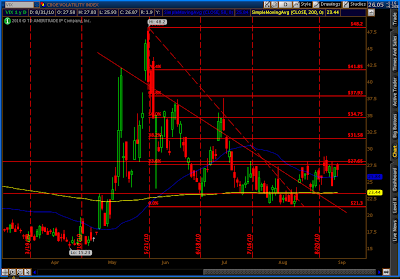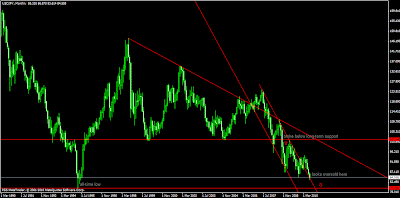While equities have been trading in a tight range on low volumes during a seasonally slow summer, I expect volatility to increase as traders and fund managers return from vacation. Given deteriorating fundamentals, I believe upside for the S&P is probably capped at 1,130 with significantly more downside risk. Although I am not in the double-dip camp, I believe uncertainty has persisted due to worsening economic data and looming November election, and should continue to weigh on the markets. Until we get better economic data and clarity out of Washington, investors' appetite for risk will remain low. The VIX (CBOE volatility index) has been consolidating in a tight range (~23-28) as well after escaping a steep downtrend and looks poised to break out. I believe the VIX should break to the upside as risk aversion typically increases as we approach year-end.
Tuesday, August 31, 2010
Monday, August 30, 2010
Will Japan's Intervention Curb Yen?
On the heels of a rising yen, Japanese leaders recently warned about potential intervention in the currency market and announced measures last night aimed to weaken the currency, proposing new economic stimuli and easing monetary policy further. Will these steps be enough? The government has been incompetent for the last two decades as it has failed to solve the deflationary spiral resulted from a major credit bubble in the late 1980's. On the other hand, demographics are extremely unfavorable as aging population (1/3 over age 65) also adds to deflationary pressure. The Bank of Japan has kept interest rate at zero and the government has taken on huge amount of debt (debt/GDP nearly 200%) in order to boost economic activity. You might wonder why the yen has risen given these terrible data points. The answer is Japanese businesses and households had sent their money from cheap loans and savings abroad to invest in higher-yield assets, taking advantage of the interest rate differential. The carry trade worked beautifully during the boom years, but was halted and reversed when countries from the U.S. to Germany to China were forced to slash interest rates in order to cope with the worst recession since the Great Depression. As a result of the reversal, a shortage occured, and supply/demand has driven up the yen to 15-year highs. Therefore, I believe the yen will continue to strengthen and should retest its all-time high vs. the USD (79.74 in 1995) as countries in the developed world are still years away from raising rates, making their respective currencies good carry-trade candidates. From a technical perspective, the USD/JPY cross currently looks oversold, so I recommend waiting for a retracement before shorting again.
Wednesday, August 25, 2010
Bad News, Good Price Action!
We again got terrible data out of the U.S. this morning as both durable goods order and new home sales came in below consensus estimates. However, while the S&P took a deep dive in early trading, it quickly bounced off the low at 1,040 (key technical support) and ended the day up 3.5 points. Good news, bad price action (sell), good/bad news, good/bad price action (hold), bad news, good price action (buy). Therefore, I maintain my short-term bullish view on the market and will be looking to buy stocks that have been hit hardest such as technology shares. I believe stocks like IBM, Microsoft, Intel, etc. offer decent value with dividend yields in the 2%-3% range.
Monday, August 23, 2010
Will The Gold Bubble Finally Burst Due To Disinflation and Rising USD?
Despite my disbelief in the gold story, I have actually been riding the uptrend and profitting along the way because "bubbles always go higher than you think!" In recent days, the metal everyone loves has been losing momentum since reaching an all-time high at $1,265, so what is next for gold? Historically, gold has done well during periods of inflation and/or USD weakness (since all commodities are denominated in USD). For example, gold did exceptionally well in the 80's because we had enormous inflationary pressure. The latest bull run in gold started in late 1999, corresponding with the start of the bear market for the greenback. However, I believe we are currently living in a disinflationary/deflationary environment as debt-deleveraging on every level (federal govt, state govts, businesses, and households) continues to weigh down on consumer prices. On the other hand, the Dollar has shown pockets of strength as fear has halted the carry trade and attracted flows to the currency. Technically, the metal has completed a 5-wave uptrend (check Elliot Wave Theory for more detail), suggesting that a correction is likely and imminent. In addition, while gold has continued to appreciate in recent months, gold producers' shares have surprisingly lagged, providing more confirmation for my thesis.
Actionable recommendation: Short gold at spot (1,225) or around 1,265 (all-time high) with stop loss somewhere above 1,300 (depending on your risk tolerance) and take profit around 1,044 (38.2% retracement).
Sunday, August 22, 2010
Turning Bullish! Resilience in Tech Shares and Sell-off in Treasuries Stir Optimism!
"When you have a conviction, you will get beat up by the market!" Frankly, this is the best advice I have ever gotten during all these trading years. I covered my shorts last Friday and actually bought some technology stocks (RIMM, AAPL, GOOG, to name a few) because I was surprised by the resilience in these technology shares. While the broad market was down, the Nasdaq finished the trading day in the green, and it was one of the few days in which technology stocks outperformed the overall market in recent months. In addition, treasuries retreated from recent highs as yields on 10-year notes increased to 2.6120%. I believe these two divergences are a good indicator of where the market is headed for the next couple weeks due to the following reasons. First, technology stocks have underperformed the market and have been the laggards throughout this correction, so any strength in the sector should be bullish for the market. Second, panic seems to have subsided somewhat given the positive reaction in the bond market last Friday. Third, the S&P quickly tested the 1065 level and found strong support there, suggesting to me that we might be headed for the top of the trading range again (first stop at ~1100, then perhaps ~1130).
Thursday, August 19, 2010
Be Selective When You Short The British Pound!
The five common GBP pairs are: GBP/USD, GBP/JPY, GBP/CHF, GBP/AUD, and GBP/CAD. If you are bearish about the Sterling, make sure you have done enough homework before you short it because you can easily find yourself on the wrong side of the market. One of the reasons is that all these pairs are historically distressed as a result of the banking crisis in 2008 when the British financial system almost fell on its knees due to souring bets on subprime mortgages. Therefore, four out of the five pairs (with the exception of GBP/USD) have been consolidating within a tight range, making the risk/reward less compelling. However, the GBP/USD had a strong run from the middle of May until early August, rising from ~1.42 to ~1.60, thus making it the best target to bet against, in my opinion. As you can see from the chart, the pair declined sharply from 1.60 and has since been trading in the 1.5560-1.5690 range. I recommend selling the cross around 1.5625 (middle of the trading range) with a take profit and stop loss at 1.5355 and 1.5765, respectively. Happy trading! :D
Wednesday, August 18, 2010
Since Most Things Are Consolidating, Let's Talk China!
To trend traders, nothing is more painful than when things are in consolidation mode, which is what we have currently. Since there is nothing much to trade, I have decided to talk about China. China, as we all know, has successfully leaped from an agriculture-driven economy to one that is powered by exports, made possible due to cheap labor costs. The country alone has stolen the entire manufacturing base in the developed world and is currently the biggest exporter in the world (Germans will argue otherwise). However, I believe the export-driven growth model ended in 2008 when American consumers, hamstrung by debts, began to retrench and save. On the other hand, the massive stimulus implemented by the Chinese government has dramatically increased inflationary pressure, illustrated by rising food prices and wages. Slowing export demand and higher wages, coupled with excess capacity and strengthening Yuan will continue to adversely affect the sector, in my opinion. Government officials have noticed the problem and directed their focus to growing domestic consumption. However, while China recently surpassed Japan as the #2 economy in the world, its per-capita income ranked #127, lagging behind countries such as Albania and Algeria. As a result, I believe the re-balancing will happen very slowly and the economy remains very vulnerable to external shocks. History tells us that no country has risen to power without a major crisis, and therefore, I suspect "this time is different" for China...
Monday, August 16, 2010
S&P Stuck in Trading Range (1056-1129) ...
The fact that S&P has been stuck in a tight trading range shouldn't surprise anyone... I believe the index is oversold in the short term and could quickly retest 1,100 before falling again. It recently broke down from a rising wedge and fell nearly 57 points from its previous peak (1,129), suggesting a quick sucker's rally isn't out of question. Fundamentally, there doesn't seem to be any short-term catalyst which can get the index out of its trading range, and therefore I remain extremely short-term sighted and continue looking for quick long and short opportunities. While I remain pessimistic over the growth prospects in the U.S., I do not foresee a "double-dip" for the economy due to record-low interest rates and pending election in November. I believe the Democrats are willing to shoot every bullet in order to keep the ship from sinking before the election.
US Dollar Still Technically Bullish!
I believe the U.S. Dollar rally started in late November following a better-than-expected job report has legs despite recent weakness. The Dollar index (DXY) last peaked at 88.70 on June 7th and corrected by nearly 60% to 80.09 in two months. Technically, the index was able to hold the uptrend at 80.04 (previous major low), and has since broken out of the downtrend. Therefore, I would be very cautious about shorting the greenback in the near term and would be looking for opportunities to long the dollar against the usual suspects (Euro, British Pound, and commodity currencies), but would leave the USD/JPY and USD/CHF alone as the JPY and CHF have remained strong given their safe-haven status.
Subscribe to:
Posts (Atom)






